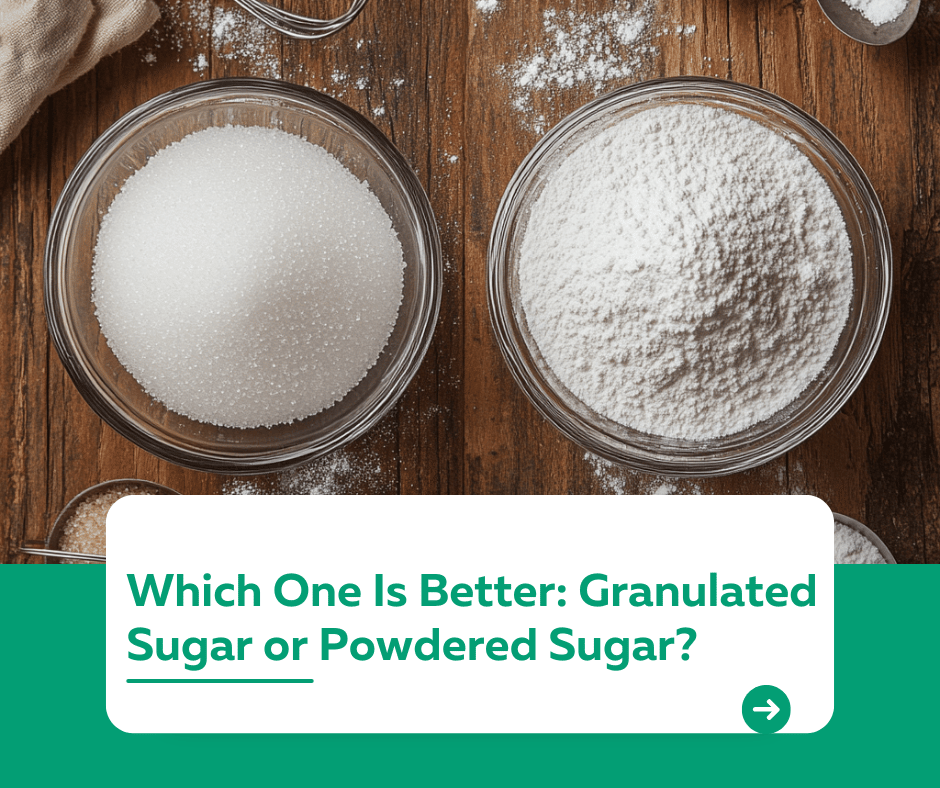
Introduction
“Which one is better: granulated sugar or powdered sugar?”
Sugar is a fundamental ingredient in baking and cooking, but not all sugar types are interchangeable. Granulated sugar and powdered sugar serve different purposes and bring unique qualities to recipes. In this article, we’ll explore the differences between granulated and powdered sugar, their best uses, and how to decide which one to choose for your culinary creations.
1. What Is Granulated Sugar?
Granulated sugar is the most common type of sugar found in kitchens.
- Characteristics:
- Made of small, fine crystals.
- White and free-flowing.
- Not prone to clumping.
- Best Uses:
- Baking: Cookies, cakes, muffins.
- Sweetening beverages.
- Caramelization and syrups.
Pro Tip: Granulated sugar provides structure and stability in baked goods.
2. What Is Powdered Sugar?
Powdered sugar, also known as confectioners’ sugar, is finely ground sugar mixed with a small amount of cornstarch.
- Characteristics:
- Soft and powdery texture.
- Contains cornstarch to prevent clumping.
- Dissolves easily in liquids.
- Best Uses:
- Frostings and icings.
- Dusting baked goods for decoration.
- Making whipped cream and ganache.
Pro Tip: Use powdered sugar for smooth, creamy textures in frostings and fillings.
3. Granulated Sugar vs. Powdered Sugar: Key Differences
- Texture:
- Granulated sugar has a coarse, grainy texture.
- Powdered sugar is fine and soft, perfect for creating smooth finishes.
- Sweetness:
- Both have similar sweetness, but powdered sugar may taste slightly different due to the cornstarch.
- Uses in Recipes:
- Granulated sugar provides structure and volume in baked goods.
- Powdered sugar blends seamlessly for creamy, decorative purposes.
- Solubility:
- Powdered sugar dissolves more quickly, making it ideal for uncooked recipes like glazes.
4. Can You Substitute One for the Other?
Substituting granulated sugar for powdered sugar (or vice versa) depends on the recipe:
- Granulated Sugar in Place of Powdered Sugar:
- Not recommended for frostings or glazes, as it won’t dissolve properly.
- Powdered Sugar in Place of Granulated Sugar:
- Possible for some recipes, but the added cornstarch may affect texture.
Pro Tip: If needed, make your own powdered sugar by blending granulated sugar in a food processor until fine.
5. Which One Should You Choose?
- Choose Granulated Sugar If:
- You’re baking cookies, cakes, or muffins.
- You need sugar to caramelize or create structure.
- Choose Powdered Sugar If:
- You’re making frostings, glazes, or whipped cream.
- You need a decorative finish on baked goods.
Conclusion
Both granulated sugar and powdered sugar have their place in the kitchen, each offering distinct benefits. Understanding their differences and ideal uses ensures you choose the right sugar for your recipes. Whether you’re baking a cake, whipping up a glaze, or adding a finishing touch, the right sugar makes all the difference.
For more ingredient comparisons and baking tips, visit our Kuestion.com.